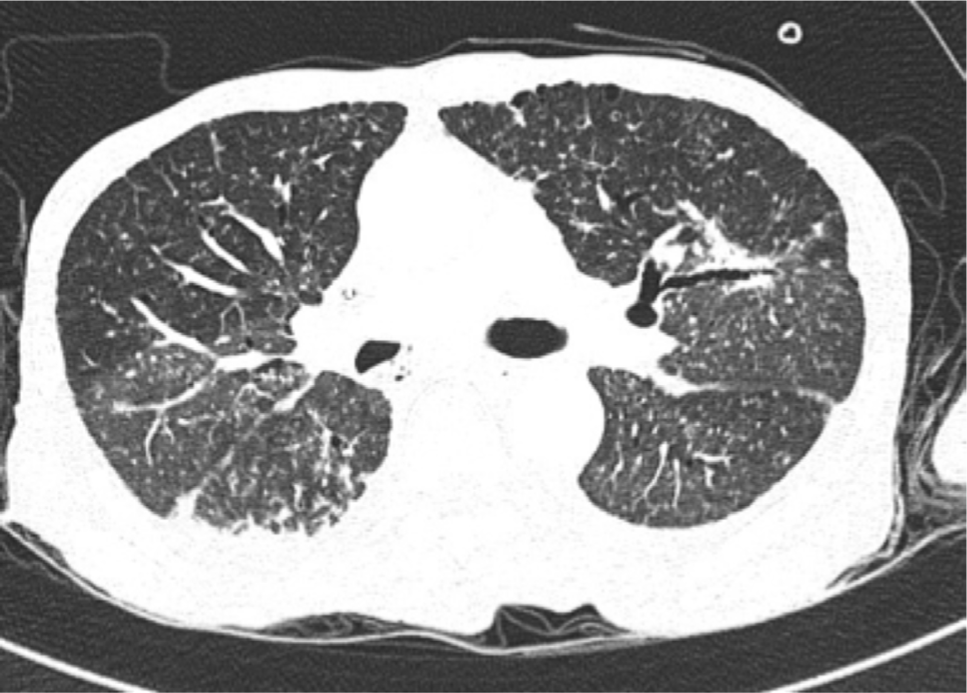서론
폐결핵은 객혈, 발열, 기침, 호흡곤란과 같은 호흡기계 감염으로 인한 직접적인 증상과 함께 피로감, 체중감소 등이 동반된다[1]. 속립성 결핵(military tuberculosis)은 결핵균의 초기 감염 후 림프 및 혈액을 통한 체내 광범위한 파종으로 인해 발생하는 질환으로 폐 이외에도 다양한 장기에 영향을 미쳐 단순 폐결핵보다 더 큰 장애를 초래할 수 있다[2].
결핵을 포함한 중증의 폐 질환은 호흡곤란은 물론 근력 약화, 신체적 및 정신적 장애, 삶의 질 저하와 같은 매우 다양한 문제를 일으키며, 이는 결국 여러 기능 문제로까지 이어진다[3,4]. 이 중 보행장애는 이동을 제한시키기 때문에 환자들이 겪는 아주 심각하고 불편한 증상으로 보행 기능의 회복은 재활치료의 주요 목표 중에 하나이다.
로봇-보조 보행 치료(robot-assisted gait training, RAGT)는 1990년대 말부터 상용화된 재활 치료 방법으로 반복적으로 정상 패턴에 가까운 보행의 경험을 제공함으로써 보행 기능을 호전시킨다[5]. 하지만 기존의 RAGT는 주로 뇌손상이나 척수손상과 같은 신경학적 원인에 의한 보행장애가 있는 환자들을 대상으로 연구가 이루어져 왔고, 호흡기 질환으로 인한 신체장애가 있는 환자들에 대한 보고는 거의 없는 실정이다.
우리는 속립성 결핵 이후 장기간 입원 치료를 받고, 독립적 보행이 어려웠던 환자에서 RAGT를 적용하여 성공적으로 보행 훈련이 가능했던 환자의 증례를 보고하고자 한다.
증례 보고
68세 남자로 2022년 3월경부터 허리 통증이 있어 촬영한 척추 MRI에서 척추골수염이 의심된다는 소견을 들었으나 치료를 받지 않고 지냈다. 2022년 4월 6일 호흡기내과 외래에 방문하여 속립성 결핵이 의심된다는 얘기를 듣고 귀가하였으나 바로 다음 날 급성 호흡곤란 증상의 악화로 인해 응급실에 방문하였다. 급성호흡곤란증후군(acute respiratory distress syndrome)에 준하여 입원 치료를 받았으며, 입원 중 결핵균이 확인되어 약물 치료를 받았다. 이후 재활치료를 함께 받다가 2022년 7월 11일 국민건강보험 일산병원 재활의학과로 전원되었다.
전원 당시 비강캐뉼라를 통해 2 L/min의 유량의 산소를 투여 받고 있었고, 노력성 폐활량은 정상예측치의 31.6%였다. 흉부 CT 검사에는 다발성의 작은 결핵 결절 및 기관지 확장증 소견이 관찰되었다(Fig. 1). 도수근력검사에서 상하지 모두 4/5 등급으로 근위약은 심하지 않았으나 신체 기능은 근력 수준에 비해 매우 저하된 소견을 보였다. 앉는 자세는 잘 유지할 수 있었지만 앉았다가 설 때에는 타인의 도움이 필요하였고, 서 있는 자세는 겨드랑이를 지탱해 주었을 때에만 10초 정도 겨우 유지 가능하였다. 보행은 전혀 불가능하였고 신체 검사 시 매우 심한 호흡곤란을 호소하였다. 일상생활 동작 수행은 대부분 타인에 의존적인 상태였다.

입원 후 호흡 재활치료를 통해 호흡재훈련(breath retraining), 상하지 근력운동과 함께 기립균형훈련을 실시하였다. 이후 타인의 보조 없이 의자에서 일어날 수 있고, 서는 자세를 유지할 수 있게 되어 2022년 8월 4일부터 RAGT를 시작하였다. 치료에 활용한 보행보조로봇은 말단장치(end-effector) 로봇(MorningWalk®, Curexo Inc., Seoul, Korea)이었다. 총 9 세션의 치료를 진행하였고 치료 완료 후 독립적 보행이 가능하여 6분 보행거리가 240미터까지 향상되었다. Modified Medical Research Council Dyspnea Scale (mMRC)은 4점에서 3점으로 향상되었고 그 외 피로감, 일상생활 동작 수행 척도, 삶의 질 등의 지표도 향상되었다(Table 1). 이후 가정 내에서 일상생활은 가능한 수준까지 회복되어 2022년 9월 2일 퇴원하였다. 퇴원 시 비강캐뉼라를 통한 산소 투여는 유지하였다.
| Before RAGT | After RAGT | |
|---|---|---|
| mMRC | 4 | 3 |
| CAT | 19 | 17 |
| 6MWT (m) | 0 | 240 |
| BFI | 59 | 42 |
| MFIS | 38 | 36 |
| LCADL | 75 | 67 |
| EQ-5D-5L | 0.192 | 0.363 |
| EQ_VAS | 70 | 70 |
mMRC: modified Medical Research Council Dyspnea Scale, CAT: chronic obstructive pulmonary disease assessment test, 6MWT: 6-minute walking test, BFI: Brief Fatigue Inventory, MFIS: modified Fatigue Impact Scale, LCADL: London Chest Activity of Daily Living Scale, EQ: Euro quality of life 5 dimension, VAS: Visual Analogue Scale
고찰
RAGT 는 신경가소성뿐 아니라 폐 기능, 근력, 균형, 고유감각 등에 미치는 효과를 통해 보행 기능의 향상을 유도하는 것으로 알려져 있다[6-9]. 따라서 중추신경계 질환 외에 근골격계 혹은 심폐 질환 환자들에게도 충분히 적용이 가능할 것으로 기대된다. 본 저자들은 이미 뇌, 척수 손상과 같은 중추신경계 질환 외에 말초신경 질환이나 파킨슨병과 같은 다양한 신경계 질환 환자들에 RAGT 적용이 가능하다는 점을 발표한 바 있다[10]. 또한 COVID-19 환자에서도 말단장치 로봇을 활용하여 성공적으로 보행 치료를 했던 환자의 증례도 보고하였다[11]. 심혈관 질환 환자에서 RAGT를 적용하여 신체기능의 향상과 균형감각을 호전시켰다는 연구 결과도 있다[12]. 현재 국내에서는 뇌졸중 환자에게 RAGT가 가장 널리 이용되고 있으나 그 외에도 매우 다양한 질환에서 임상적 활용성이 기대된다.
폐질환 환자의 호흡재활에서 가장 근본적인 요소는 운동에 기반한 재활치료이고 운동 중에서도 유산소운동이 가장 중요하다[13]. 하지만 보행이 불편할 정도의 중증의 호흡기 질환 환자에서 쉽게 적용할 수 있는 유산소운동이 마땅치 않은 경우가 많다. RAGT는 정상 보행 패턴과 유사한 움직임을 반복적으로 제공하는 것뿐 아니라 지구력 훈련 및 저항운동을 통한 근력 향상까지 기대할 수 있는 치료 방법이다[8,14]. 이러한 RAGT의 특성은 보행장애가 있는 폐질환 환자에게도 유용하게 적용이 가능하다는 것을 시사한다. 심각한 후유증이나 합병증이 없이 적용이 가능하다는 점도 매우 큰 장점으로 생각된다.
폐질환 환자에서 RAGT는 매우 유용한 재활치료 방법이 될 수 있을 것이다. 하지만 아직까지는 이들 환자에게 RAGT를 적용한 임상 연구는 많이 부족한 상황이다. 향후 더 많은 증례 보고 내지는 좀 더 큰 규모의 임상시험이 필요하며, 이를 기반으로 RAGT의 적응증이 확대될 필요가 있다고 생각된다.
